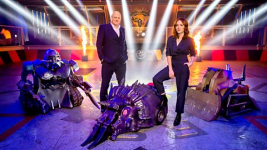
Photo Courtesy: bbc.co.uk
It is yet another pleasant Friday, the last day of the month of April. A fine time to take a trip back in time again to the later ‘90s to mid-2000s when Jeremy Clarkson had his ‘90s hairdo! Well, it was the 90s, what do you expect?!
Did you know that Jeremy Clarkson was the host of the show: Robot Wars back in the 90s. No wonder we naturally loved it back then. From his success in the Top Gear TV show, it goes without saying that he would be the best host for Robot Wars.
It was fun watching robots fight their engines off in a ring with deadly weapons attached. It was more or less like watching wrestling, only that this time the characters were robots instead. The robots came in different shapes and sizes engineered purposefully to win the war. This came at a time when robots were just beginning to evolve rapidly in terms of design, responses, AI capability, agility, and remote operation. Initially, a robot would be seen with a cable attached to its back for control and power. But as the development continued, more semi-autonomous robots were created. Thanks to the research and development in artificial intelligence.
It's nostalgia Friday again, and today we will talk about Robot Wars and why it was a kid's favorite show back in the later 90s through to the mid-2004. Robot Wars ran from 1998 to 200. It came out when we were teens back then hosted by Craig Charles (from red dwarfs). The original host was Jeremy Clarkson.
Robot wars were stood out as a show, as the robot was designed to fight each other! They would smash the hell out of each other in a big arena, all while trying to avoid the wrath of the house robots. The house robots were cool and veracious at the same time. My favorite was sergeant bash who had a flame thrower that lit up the arena and many of the more flammable robots. Then there was Matilda, who was the bad girl of the group with a chainsaw for a tail and was pretty unbeatable. The shunt was a little boring with very little weaponry, just an ax. But he was a pro at shoving robots into the pit or onto the floor flippers.
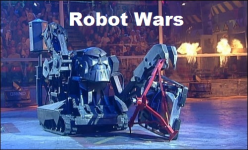
Photo courtesy: markmeets.com
Dead Metal’s deadly pincers and circular saw sounded like the very worst trip to the dentist, but it was Sir Killer lot that was the star of the show. He was the downfall of many robots as he picked them up, spun them around, and threw them in the pit.....savage. Although there were some games that the robots took part in in the earlier series, the main event was the arena battle where two robots would go in until one of them was immobilized or they ran out of time and the judges had to make a ruling.
There were many hazards around the arena with the house robots in the corner patrol zones who could attack you if you venture into their territory. Floor spikes could spell a pretty nasty end to anyone who drove over them and of course, there was the most popular feature in the arena and the end of most battles the Pit.
First off, there were some truly unique entries into this competition and while they usually didn’t do very well, the designs were sick! Before they were mashed into pulp. Some of the robots that made this war so memorable include: Megahertz, Wizard, Major Tom, Elvis, and personal favorite Millian bug. A step up from these with the robots that stood more of a chance. But it was their teams that made their robots special. We had the best dressed and highly popular Sir Chroma lot team who always took their robot home in bits. And on the other side, we had the drunk dads raping in the garage team of Plunderstorm or however many iterations it went through. But you can’t see Red fur fabric and not think of the Irish team Diotor who covered their robot in the material so that the crowd could see it go up in flames.
Now the big boys that really put up a show included Cassius who was a nippy little bugger and the one that popularized having a flipper and being able to run both ways up. It went far in the wars, which was extra impressive. Because it was the only robot that was controlled by only one person. I have to mention the panic attacks. Not for its many forklift truck design nor the side skirts that gave it zero ground clearance. No. I have to mention them because they were from Kombran, a small Welsh town for the team member. 101 and Big brother ware worth mentioning. Firstly because 101, only cost a pound and a penny to make, and secondly both teams had some damn cute kids on it. I don’t remember the name of the little girl on team 101, but I know she read a nice poem to Craig Charles sometime back.
Then there was Cool Joe on Team Big Brother. He was adorable. Gemini was such a unique robot that made the judges impose a new rule. Gemini was a cluster bot, a pair of smaller robots came from one big one. Then there was team chaos, who made the first robot that flipped the opponent out of the arena entirely. They stormed the third series competition and came out victorious.
Now to the topmost iconic robots of the game and most destructive robots were:
The Razer – Despite being the most successful robot in the history of the wars, with over 40 wins under its belt, it was a pretty cursed robot. Despite the destructive power of it hydraulic crusher, it broke down in its second war. It lacked a self-righting mechanism the importance which was not fully realized at the time. In the third war, they broke down yet again in the heat during a fight with Agrobot. And they were eliminated from the competition far too soon. And then in the fouther war, they were eliminated from the heat when they got wedged on the arena wars during the fight against Pussy cat. They did finally overcome their technical problems to win the fight wars. Photo Courtesy: Reddit.com
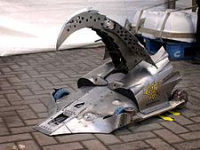
Hypnodisc – This was my favorite robot in all of the wars. With its unique and deadly spinning disc that wrecked all that stood on its path. No one saw this robot coming and it changed the game entirely. The team consisted of two brothers and their dad. But despite its awesome destructive powers, it too ran into some problems in series three when it spun itself all the way to the final against Chaos II but with no self-righting mechanism, hynodisc was flipped over and lost the title. They faced Pussy Cat on the finals of the fourth wars but damage to their back wheel caused them to get stuck and then they were bashed. In the fifth war, they were busted by big brother. I wished it won the war, but it never did.
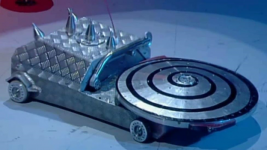
That is a brief of the robots I loved and how I remember the show. Let us now look at a brief history of the Robot Wars TV series.
A look at the History of Robot Wars (1998 – 2005).
Robot Wars is a robot fighting competition aired on British television from 198 to 200, and again from 2016 to 2018. Every series featured teams of amateur and skilled roboteers battling it out in an arena made of steel and bulletproof glass, complete with arena hazards and areas populated by aggressive and heavier House Robots. The earlier version of the series featured attack and trial courses for competitive robots.
The first version of the show aired on BBC Two from February 20, 1998, to February 23rd, 2001, on BBC Choice from October 8th of 2001 to 2003. It was later repeated on BBC Two, and on channel 5 from 2003 to 200. From July 2016 to January 2018, the show was revived on BBC Two.
To date, the show has aired ten main series, each centered on a single competition, two Extreme series with several unrelated incidents, and several special episodes.
The first series was hosted by Jeremy Clarkson with Craig Charles taking over from the 2nd to 7th series. Philippa Forrester was a cohost on the first three episodes, as well as the fifth, sixth and Extreme 2. From 1998 to 1999, Forrester also hosted the spin-off series Robot Wars Revealed. Julia Reed co-hosted the fourth series and Extreme 1, and Jayen Middlemiss hosted the seventh. Dara Brian and Angela Scanlon hosted the relaunched season. For the entire season, Jonathan Pearce provided commentary.
Additional series were shot at the UK location for various segments of the global market, which included two series of Robot Wars Extreme Warriors with American Competitors for the TNN network (Hosted by Mick Foley with Rebecca Grant acting as pit reporter), two series of Dutch Robot Wars for distribution in the Netherlands, and a single series for Germany. The fourth series of UK Robot Wars aired on TNN in the United States in 2002 as Robot Wars: Grand Champions, hosted by Joanie Laurer.
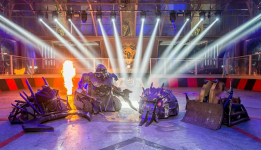
Robot Wars merchandising was successful back then, and it was one of Logistix Kids’ best-selling toy lines in 2002. It came with a mini arena, pullback, friction and ripcord toys, as well as radio-controlled House robots.
The roboteers joined The Fighting Robot Association in 2003, and they continue to compete in competitions for new audiences with the help of associated event organizers. Roaming Robots bought the rights to the Robot Wars brand from Robot Wars LLC in 2013 and used the name for their traveling robotic combat show. The name Robot Wars was withdrawn from live shows in early 2017, and the show was now referred to as Extreme Robots.
With a climax audience of over 6 million viewers in the UK in the later 90s, the format went on to become a global hit, airing in over 45 countries including the United States of America, Australia, Canada, China, India, Germany, and Italy. After eight seasons, it was dropped by BBC Two in 2003, and Mentorn revealed that it would make 22 episodes for Channel 5, ending with The Third World Championship in March of 2004. Due to low ratings, Channel 5 canceled the show after one season.
The show returned to BBC Two in July 2016 with a new arena, house robots, and presenters. The first episode was well-received, becoming the top trending subject on Twitter that evening and garnering two million views, more than the previous episode of Top Gear’s 23rd series in the same 8 pm Sunday slot only a few weeks earlier. The revived show was broadcasted for three seasons before being canceled again in March 2018.
American Robot Wars Events.
Robot Wars was created by Marc Thorpe, a designer for Lucasfilm’s LucasToys division. After failing to produce a radio-controlled vacuum cleaner back in 1992, Thorpe had the initial idea for a robot fighting sport. Marc Thorpe founded Robot Wars in 1994 and hosted the premier competition at the Fort Mason Center in San Francisco. Thorpe formed relationships with a New York-based record label called Sm
The Robot Wars (TV Series)
Centered on the Robot Wars idea, Gutteridge and one of his producers, Steve Carsey, produced a television format. They staged a live event opposite the BBC Television Center in Wood Lane, Shepherd’s Bush, London, and employed Derek Foxwell to create three battle robots, two of which were called the Mouse and Grunt, who would ultimately take part ii the first UK series of Robot Wars, to compete against three American robots, Thor, La Machine, and The Master, both of whom were veterans of the original American competition.
Michael Jackson, the Controller of BBC Two, attended the event, which was not filmed, and agreed to commission a series. However, it wasn’t until 1998 that a subsequent Controller of BBC Two, Mark Thompson, fulfilled Jackson’s pledge and ordered six episodes. Foxwell was the technical supervisor and senior technical consultant and Guttridge and Carsey were the producers. He wrote the rules and regulations and oversaw the pit area and the technical staff, which scrutinized the robots, moved them on and off stage, and assisted contestants in repairing their robots. Mat Irvine, who was originally a member of the technical committee, served on the judging panel in 2002 and 2003.
Noel Sharkey was the head judge on all series from 1998 to 2003 and again from 2016 onwards. Eric Dickson (1998), Adam Harper (1998 – 99), Marin Smith 1999 2003, Myra Wilson (2000 – 01), Mat Irvine (2001-03), Sethu Ijayakumar (from 2016 onwards), and Lucy Rogers made up the three-person judge panel.
The profile requested no input or permission from Thorpe before doing so, escalating the already strained relationship between Thorpe and Profile Records and indirectly fueling legal dispute over ownership of the Robot Wars concept. The legal proceedings continued until February 2002. Mentorn, on the other hand, used Thorpe as a consultant on the program, and the first season of Robot Wars in the UK aired over six weeks in February and March 1998. It was an instant success, with over two million viewers, and the BBC ordered an additional 18 episodes that year.
In total, 155 episodes were made, and the show was broadcast in 26 countries. In the United States, two series were produced for The National Network ( Paramount Network), and a version was also shown on Nickelodeon. The UK series was shown on TechTV in the United States. Many European countries have produced the series. Despite the fact that the series had a variety of directors and producers, all of them were produced in the United Kingdom by Mentorn and executive produced by Tom Gutteridge and Steve Carsey. The first series was staged in various London film studios, but the stage and pit area became too large to fit into any of the traditional studios, so shooting was later relocated to an aircraft hangar at RAF Newton.
Viewership tanked again in the early 2000s, hitting just 1.2 million in the sixth season, the last to air on BBC Two. Following its switch to channel Channel 5 in November 2003, the show premiered in a new Sunday night slot with one million viewers, but the rating soon dropped to 800,000 forcing the show to move to Saturday nights after just three episodes.
After Robot wars ended, an edited half-hour version of the series aired on Fox Kids (later Jetix) beginning in 2004, on Bravo Beginning in 2005, on Dave beginning in 2010, and on Challenge beginning in 2016.
The Revival: The Rise and Fall of Robot Wars.
Robot wars gain popularity very first back then, but at the same tie, the interest, and demographics of people interested in it started to plummet. The BBC announced in January 2016, that the show will be revived for a six-part season. Dara Briain and Angela Scanlon anchored the relaunched season, with Jonathan Pearce returning as a commentator.
The first episode aired on July 24th, the same time as Top Gear. Some original series robots, such as Behemoth and Storm II, as well as four of the original House robots were updated to be stronger, quicker, better armed, and with new looks.
The 2016 season was shot in a warehouse at Renfrew’s Westway Park. With over 2,000 tweets, the first episode earned approximately 2 million viewers and was the most trending subject on Twitter at revival.
The first revived series was often referred to as Series 1 during its initial broadcast, introducing itself as a brand new program. However, beginning in 2017, the BBC started referring to it as Series 8, with the subsequent second series aptly called Series 9, seeing it as a continuation of the original show.
Following the 10th series, it was announced that the BBC had opted not to renew the show for an 11th season, and Robot Wars was canceled for the second time, prompting fan outrage.
Robot Wars Gameplay: The Rules of the Battle Arena.
During the show’s knockout format, a robot may lose a match in a variety of ways, including:
- Immobilization – A robot that is immobile is counted out. The original series needed 30 seconds of immobility; later series reduced this to 10 seconds.
- Pit – the pit of oblivion, a huge square hole in the ring, is one of the arena’s hazards. A robot that falls into this or is forced into it is destroyed.
- Removed from the arena – A robot is eliminated if it is rejected from the arena, usually by an opponent’s flipper or vertical flywheel. The boundary of the arena had a short barrier in the original series; in the latter series, the wall was higher, making this form of elimination more difficult. Only those parts of the arena were not completely walled off in the revival series. As a result, removal from the arena was only feasible in some locations.
- If none of the above conditions were met, the competitors were rated on style, power, injury, and aggression by a panel of three judges. The judges' decisions were based on:
- Aggression – which is the degree to which the robot was on the front foot against the opposition robot rather than keeping out of trouble.
- Damage – the amount of harm done to the opposing root.
- Control – the driver’s ability to push competing robots while avoiding arena hazards and attacking in the proper manner.
- Style – this only featured in the original series. It was the degree to which the robot displayed its kills, such as self-righting. The style category was removed from the revival season.
Despite the fact that the format has changed many times over the years, these rules have stayed consistent throughout all the series and competitions.
How do you remember the Robot Wars Presenters?
Jeremy Clarkson

Image Courtesy: fandom.com
Jeremy Clarkson hosted the first season of Robt Wars, which was hosted in Philippa Forrester. In keeping with his edgy persona from Top Gear, Clarkson often made sarcastic remarks about revivals and their robots, such as remarking that a contestant’s robot named Skarab looked like cheese on toast!
Craig Charles
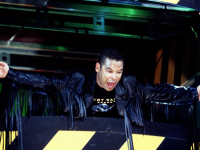
Clarkson left Robot Wars after the first season, and Craig Charles took over from him. Charles who played Dave Lister in the science fiction-themed sitcom Red Dwarf was seen as taking the show and its contestants more seriously than Clarkson and was more positive when presenting.
Charles would end each episode with a four-line poem titled Robot Wars. Charles hosted Robot Wars until it was canceled in 2004.
Philippa Forrester
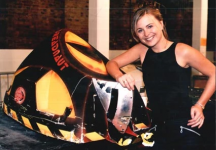
Philippa Forrester was the best know as co-host of the science and tech programme called Tomorrow’s World, in contrast to Charles’ experience in science fiction. Her job on Robot wars was as a pit reporter, interviewing contestants about their robots before and after fights. Forrester served as a pit reporter for six of the show’s nine seasons, with Julia Reed filling in for Series 4 and Extreme 1 while Forrester was unable to participate due to pregnancy, but Forrester returned for Series 5, Series 6, and Extreme 2.
Forrester did not return to the show when it shifted to Channel 5 for the seventh series for undisclosed reasons, so Jayne Middlemiss took over as pit reporter.
Jonathan Pearce
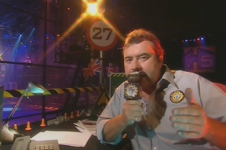
Jonathan Pearce was the show’s analyst for the duration of its run, being one of only two people (the other being judge Noel Sharkey) to appear in every episode; he commented in the same loud and enthusiastic manner as his football commentary.
The show was famous for phrases like Roboteers, stand by, 3.2.1 activate, and cease. The producer, Stuart McDonald, revealed these worlds, which were a recognizable part of the series for the remainder of its run.
Dara Briain and Angela Scanlon were confirmed as the eighth series’ hosts in 2016, with Jonathan Pearce returning as a commentator. They played the same character in the ninth and tenth seasons.
What about the House Robots?
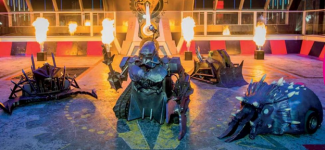
House robots served as obstacles to competing robots in fights and challenges in the season. House robots were allowed to assault robots in the arena’s Corner Patrol Zones or upon submission of a competing robot. The house robots were an integral part of the program’s development, and their merchandising was extremely popular.
Additionally, the house robots were not subject to the 100kg weight cap or weapon rules that contestant robots had to follow, with Sergeant Bash’s flamethrower being the most notable example.
During fights, since the Fourth wars, a non-competitive “Refbot” was present in the ring. This robot communicated officiating signals like counting out immobile competitors on the arena, provided occasional nudge to help battles progress, and could deploy fire extinguishers if necessary.
New versions of Matilda, Shunt, Dead Metal and Sir Killalot were developed for series 8. They were much heavier and have better weaponry. All of the house robots weigh more than 300kg, and Sirl Killabot now weighs 741 kgs. Visually, all four resemble their predecessors, but there are important differences: Matilda’s back-mounted fins have been replaced with smaller crocodilian scales, spikes appear on her frill, her eyes are now red, and here whole head portion now flips up; Shunt has expanded wheel protectors and metal chimneys replacing the smokestack, and Sir Killalots armor and helmet have been completely revamped. This was said to display the outline of Sir Killalot’s head rather than the helmet he is wearing. The other house robots did not make an appearance in this season.
Robot Wars playground and Hazards.
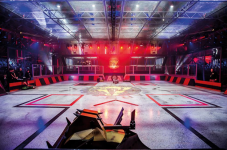
Photo Courtesy: TBIvision.com
Several arena incarnations were used during the original run of Robot Wars on BBC. A global variant, such as Robot Wars: Extreme Warriors in the United States, have sued these arenas. The area was about 23 by 48 feet. The area was not enclosed from Series 1 to 3, since the audience was elevated above the arena.
The increasing complexity of contestants’ robot weapons, most notably demonstrated by Hypno-Disc in Series 3 prompted producers to enclose the area entirely in a Perspex box 20 feet high from series onwards to shield the audience from debris.
The Robot Wars arena was acquired from the television production firm Mentorn in early 2004 by a corporation named Robot Arenas Ltd., based in the United Kingdom, an organization established by a former Robot Wars competitor to continue the sport of robot fighting in the United Kingdom. The arena, which had a value of over 11,000 UK pounds at the time, was sold for scrap in 2005 for 250 Sterling pounds by the new owner of the former RAF Newton airbase, where it was housed. A suit brought by Robot Arenas Ltd. against RAF Newton found that RAF Newton behaved fairly in the matter and owed no money to Robot Arenas Ltd.
A new arena was built in a warehouse in Renfrew, on the outskirts of Glasgow, in 2016 for use in the reboot series. This arena is 15 Square Meters, with a 6mm steel floor and higher bulletproof walls, making it more difficult for robots to be thrown out.
Hazards in the Robot Wars Arenas.
Arena hazards were added and changed over the course of the different Robot Wars series. In general, hazards that were ineffective were removed from later series; however, some hazards that were successful like the pit of Oblivion, Floor Flippers, and Dropzone were kept. The following were among the various hazards that were in the arena which varied from one series to the next:
- Sidebars – Features on the first wars only. There were pieces of the arena side fence that were lying on the floor. The robots were trapped and potentially immobilize if they were unable to move away.
- Patrol Zone – Just for the first Wars only. Four wide squares marked with striped tapes in the arena's corners, each occupied by one House Robot and a threat. When a competitor robot enters in these areas, it was vulnerable to attack from the House Robot inside. The Patrol Zone was similar to the CPZs seen in later episodes but much larger.
- The Floor Grilles – Grille floor panels, similar to the arena sidebars mentioned above, were designed to trap robots and prevent them from driving away. It is much more powerful than sidebars.
- Floor Spikes – appeared in the first, third wars, and series 8 and later. These were pneumatic spikes placed on the arena floor that sprung up whenever a robot drove over them. They captured robots and sometimes flipped them. They were withdrawn for series after causing several upsets during the Third Wars, in which robots that were currently winning battles were tripped and then lost. This occurred more prominently during Heat B when Behemoth was flipped, and unable to self-right, and its competitor Pitbull won by default. One of the four major hazards of the arena in series 8 is a collection of five big spikes. They are strong and big enough to raise and trap robots for a brief period of time. This happened to Bonk in the first episode, but they are slower than their predecessors. In principle, this would prevent the kinds of upsets that occurred in Series 3. Sparks can be emitted by a single spike hole.
- The perimeter Patrol zones (PPZs).
- Side Patrol Zones (SPZ).
- Pit of Oblivion.
- Flame Pit.
- Corner Patrol Zones.
- Floor Flipper.
- Red and Blue Perimeter.
- Angle Grinders.
- Pneumatic Spikes.
- Co2 geysers.
- Drop Zone.
- Disc of doom etc.
Final Thoughts.
I really wish that this show is revived. It really deserves a reboot. With the advancement in technology including laser and other precision technologies, I bet this game will be much fun. Can’t wait for a reboot!
Did you watch Robot Wars as a kid, and who were your favorite robots? Let us know in the comments below.



